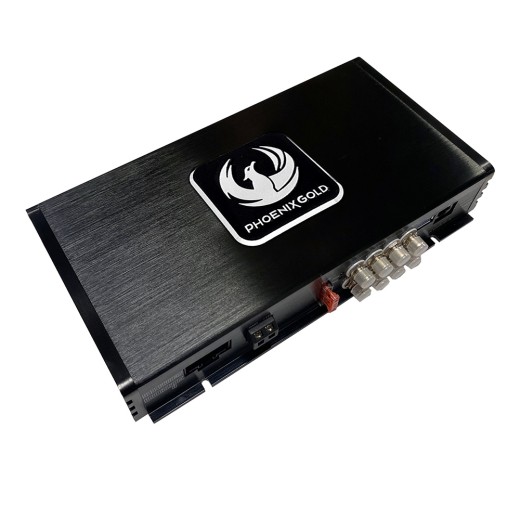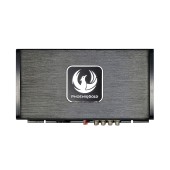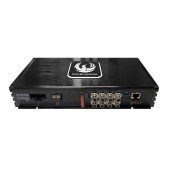Phoenix Gold ZDA4.6 amplifier
More about the product
- Use our consulting room
- You can return the goods to us within 14 days
- Try the product at our store
Phoenix Gold ZDA4.6 amplifier
The ZDA4.6 is an extremely versatile digital signal processor (DSP) with a built-in 4-channel amplifier. The 6-channel DSP gives you all the features you need to create your perfect audio setup, such as fully adjustable filters, EQ with adjustable Q value and time correction. But this feature-packed amp doesn't stop there, the built-in 4x60W RMS amp runs channels 1-4 on the DSP, so you're in full control. If you want even more power, you can even use the 6-channel RCA outputs, which are also controlled by DSP. The ZDA4.6 will run on any source, connect the high level input and that will be your source, or you can use the RCA input. You can even add a BT module to the amplifier to get high-quality streaming and full APP control via iOS or Android devices. There is also a remote control unit that allows volume and bass control along with memory recall. The remote also gives you a USB input on the front, which makes it easy to connect to a computer and make adjustments to the front of the vehicle. But it doesn't stop there, with the ISO-T harness available as an accessory, the ZDA4.6 becomes the perfect integration amplifier. It takes the high-level input from the car, passes it through DSP and sends it from the internal amplifier to the car speakers, giving you the power and control you need. If the power is not enough, simply add a second normal amplifier and you have full DSP functionality, so that the additional amplifier acts as a SUB amplifier for even more power for your high-performance speakers.
Main features of the Phoenix Gold ZDA4.6 amplifier
| Catalog number | ZDA4.6 |
| Brand | Phoenix Gold |
| Links | Official web presentation (English) |
| Number of amplifier channelsAmplifiers are divided into: - Monoblocks - 2-channel - 3-channel - 4-channel - 5-channel - 6-channel - multi-channel Each channel is used to power one speaker for the coaxial type, or one side if they are component speakers. Monoblock type amplifiers are mainly used for subwoofers. 2-channel are suitable for both subwoofers and, for example, the front pair of speakers in a car. 3-channel is used for front or rear speakers + subwoofer. 4-channel are used for front + rear speakers or 1 pair of speakers + subwoofer. 6 or 5-channel are used for 2 pairs of speakers + subwoofer, most often. Bridging means connecting the amplifier to a bridge, using the + pole from one channel and the - pole from the other channel. In most cases this is shown as "BRIDGED" on the amplifier. | 4 |
| Energy class of the amplifierAmplifiers are divided into two basic classes: analog and digital . Analog amplifiers (A/B) have higher consumption requirements, but usually have a more natural sound. Digital amplifiers (D) have significantly lower consumption and higher efficiency, but the sound may not be as faithful as with classic analog amplifiers. | D |
| RMS power into 4 ΩRMS power when loading speakers or subwoofer at 4 Ω. RMS power is the constant power of the amplifier and is one of the most important parameters when choosing an amplifier. | 4 x 60W |
| RMS power into 2 ΩRMS power when loading speakers or subwoofer at 2 Ω. RMS power is the constant power of the amplifier and is one of the most important parameters when choosing an amplifier. | 4 x 100W |
| Inputs | 2 x RCA, 4 x high level |
| Outputs | 6 x RCA |
| Integrated DSP processor | Yes |
| Number of DSP processor channels | 6 |
| Frequency rangeThe ability of the amplifier to reproduce the signal from the lowest frequency to the highest = faithfully reproduce the sound in a specific frequency band. Professionally: In the frequency range from 40 to 16,000 Hz, the vast majority of fundamental and overtones (harmonics) of all musical instruments are found. We are interested in the course of the radiated sound pressure in this range of frequencies when the loudspeaker system is supplied with constant power. We call this course the frequency characteristic, which tells us the level of radiated sound pressure in decibels (dB) depending on the frequency. The frequency characteristic of a speaker or speaker system can be expressed most succinctly with a graph. Mostly, however, the frequency characteristic is indicated by indicating the maximum tolerance of the sound pressure in the given frequency range, e.g. 50 to 15,000 Hz -+ 6 dB. Since the frequency characteristics of loudspeakers and systems in general are quite uneven, some manufacturers do not even specify this maximum tolerance of sound pressure in decibels in their catalogs for reasons of prestige. Data impoverished in this way is unfortunately worthless. What is valid is that the manufacturer offers a speaker system with a frequency range of 30 to 20,000 Hz, if he is worried about stating the maximum unevenness of the sound pressure in this range, because he can have a tolerance of, for example, +- 20 dB. The unevenness or undulation of the frequency curve in good speaker systems for high-quality music performance should not exceed +-3 dB in the 80 to 12,000 Hz band and +-6 dB in the 40 to 16,000 Hz band. Greater unevenness already depletes or emphasizes certain tonal areas, which can cause audible or even disturbing distortion. The proportion between fundamental tones and higher harmonics also changes, thereby changing the color of the sound, and individual musical instruments as well as the entire musical image sound unnatural. | 20 - 20000 Hz |
| Signal-to-noise ratioThe signal-to-noise ratio means that the output signal always contains noise. The signal-to-noise ratio expresses how much of this noise is compared to the useful signal. The so-called A value is given, which does not take deep and very high frequencies into account. This corresponds to the characteristic of human hearing, which is not so sensitive to deep frequencies, especially below 1 kHz. The higher the value, the better the amplifier is. | 102 dB |
| High level inputsThe high-level input on the amplifier allows connection directly to the existing speakers in the car without additional purchase of an external high/low adapter. Important equipment in the case of installing an amplifier on an original car radio. | Yes |
| Dimensions of the amplifier | 266 x 150 x 45 mm |





















